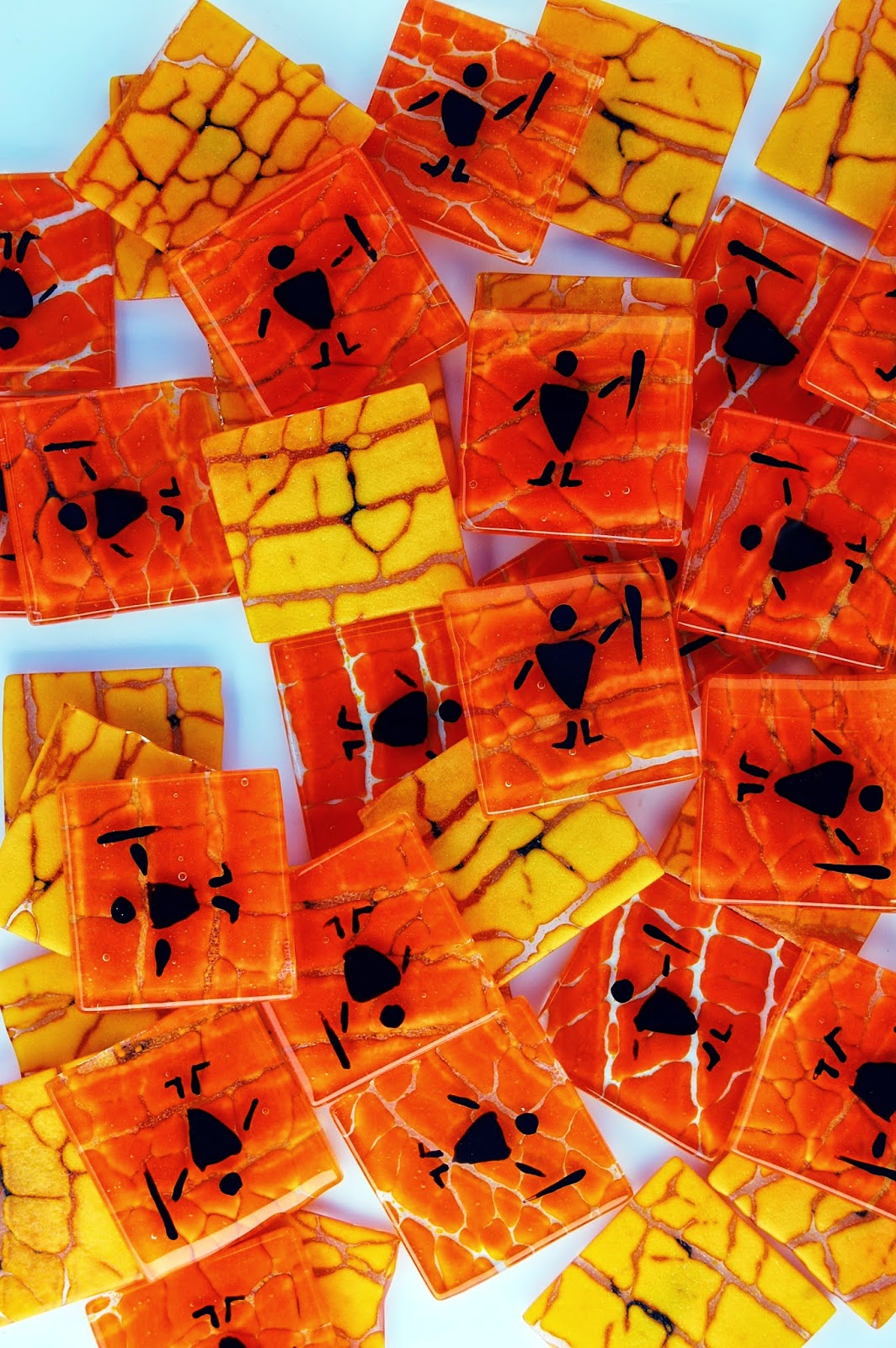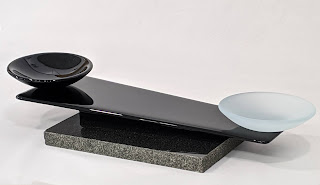Magless 2015 - Moab Man!
 |
| An Army of Moab Men |
I have been working with the crackle technique using glass powders the past several months, since taking a class with Bob Leatherbarrow in October. The results of the technique when using red, yellow, orange, and brown powders remind me of the red rock canyons of Southern Utah. My experiences while exploring Utah and the resemblance of crackle to redrock were my inspiration for this year's Warmglass Magless Exchange (www.warmglass.com).
The first step was to create a 12" square of crackle. On 1/16" fiber paper, I sifted a few spots of Chestnut Brown, then a layer of Sunflower, topped with a layer of Orange (I work with Spectrum's System 96 glass). As I worked, I sprayed the powders with water. One of the things I have found working with powders is that you can somewhat control where the powder will crack by dragging a design through it. In this instance, I used a wide tooth comb to create waves through the powder and then cracked the powder as usual. The piece was capped with clear, put into the kiln with several other crackle pieces, and fired based on a schedule I got from Bob.
 |
| Crackle in the kiln. You can see the results of dragging the comb through the powder more prominently in the circle on the far right. |
Please note: I respect the rights of other artists and those who teach. Bob Leatherbarrow shares some very specific techniques for creating crackle during his classes. I do not share those techniques. However, in the Resources section below, I have provided a link to a crackle tutorial that is freely available.
After the first firing, I cleaned the fiber paper from the back, lightly ground the edges to remove any sharp points, and then cut the piece into 1.5" squares. Note that I scored the glass on the smooth (clear) side. The easiest way I found to run the long strips was to use the push block and button from the Morton Safety Break SB01. Once I had the 12" x 1.5" strips, I broke out the 1.5" squares with my regular Silberschnitt running pliers.
 |
| Kaiser paint on left / Glassline paint on right |
Both paints have their pros and cons. I like the fast drying time of the Glassline paints (Kaiser paints will take days to dry, unless you use a heat gun), but in general, Kaiser paints produce better results.
 |
| Painting the pictographs |
I used a brush to paint the body, and then used a toothpick to paint the arms, legs, and spear. My original intent was to paint on the yellow (rougher) side of the crackle to give the pieces a sandstone-like texture. However, I guess I am a shiny-object type of gal, because in the end, I chose to paint on the smoother orange side. I was not completely satisfied with the quality of the image on the rough side, and the black contrasted with the orange was more appealing than on the yellow.
I let the paint dry for several hours, and then sped up the process using a heat gun. One thing to note about Kaiser paints is that they will spread if you dry them with any forceful air, so a heat gun is preferable to a hair dryer. However, take care not to thermal shock the glass!
All of the little "Moab Men", as I call them, were lined up on a piece of Papyrus paper and fired using the following schedule:
|
Segment
|
Rate
(deg F)
|
Target
Temp
|
Hold
|
|
1
|
500
|
1100
|
15
|
|
2
|
500
|
1400
|
5
|
|
3
|
AFAP
|
950
|
15
|
While I call these guys Moab Men, the inspiration was taken from the petroglyphs and pictographs at Buckhorn Wash in San Rafael Swell. We stopped at the wash after a beautiful day of mountain bike riding on a circuitous drive to Moab, Utah. If you're curious about the area, and the difference between petroglyphs and pictographs, I've posted a few shots of interpretive signs below.
 |
| Moab Man Maglesses, front & back |
I'll be packing these up and shipping them off in the next day or two. I can't wait to get a box full of other entries some time in late April for this year's Magless Exchange. It is always a little like Christmas opening the box and seeing all the creations of the many talented glass artists who share their knowledge on the forum and take the time to share a small piece of their art with the other participants.
Happy fusing!
Dana
 |
| Buckhorn Wash |
Crackle Tutorial http://www.glass-fusing-made-easy.com/crackle-technique.html
Kaiser Glass Paints http://www.kaiserglass.com/
For a wealth of information on glass fusing, Bullseye Glass offers on-line educational videos (small annual fee, though worth it, I think!).



